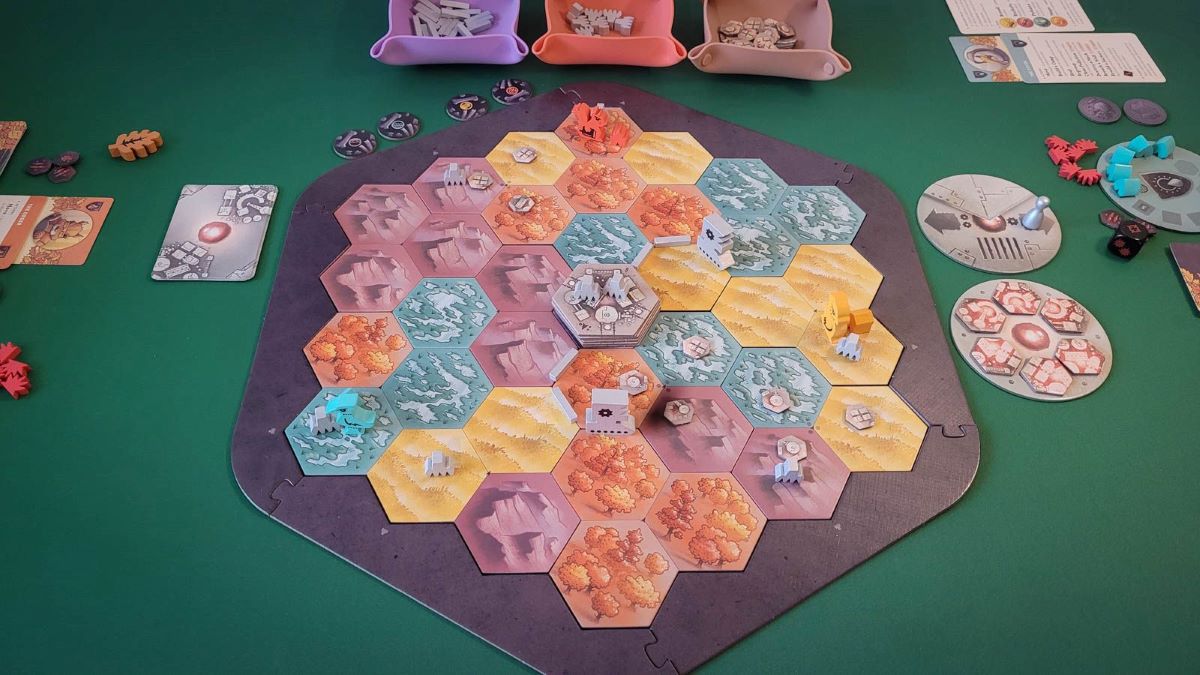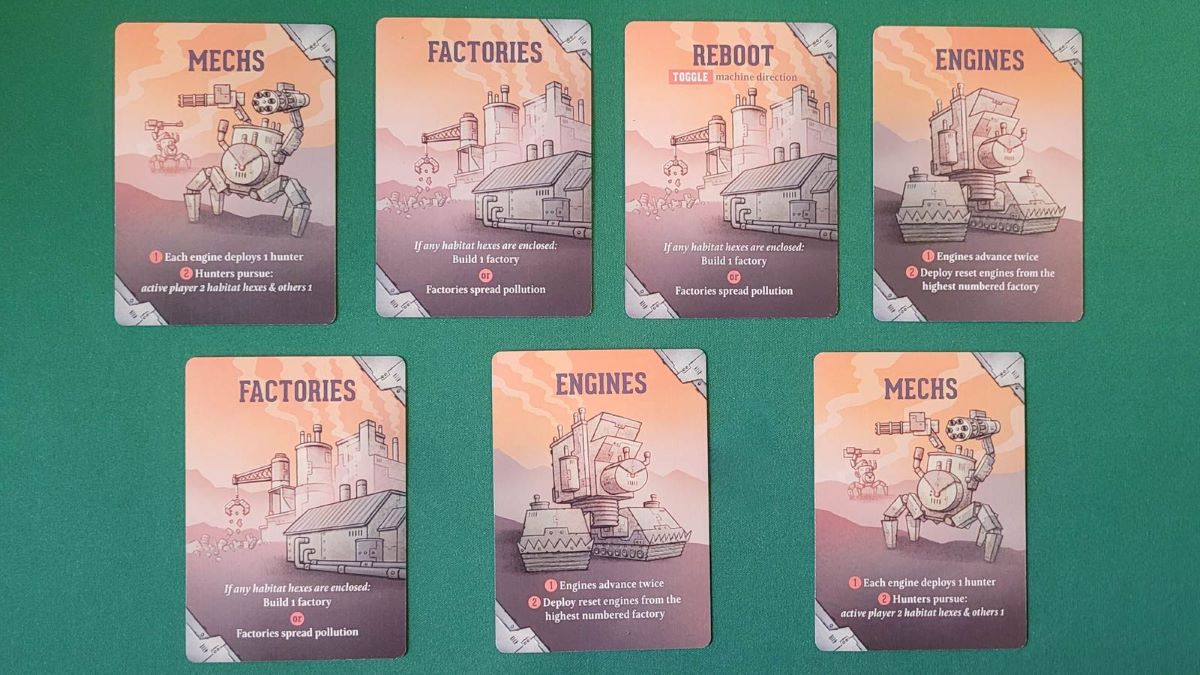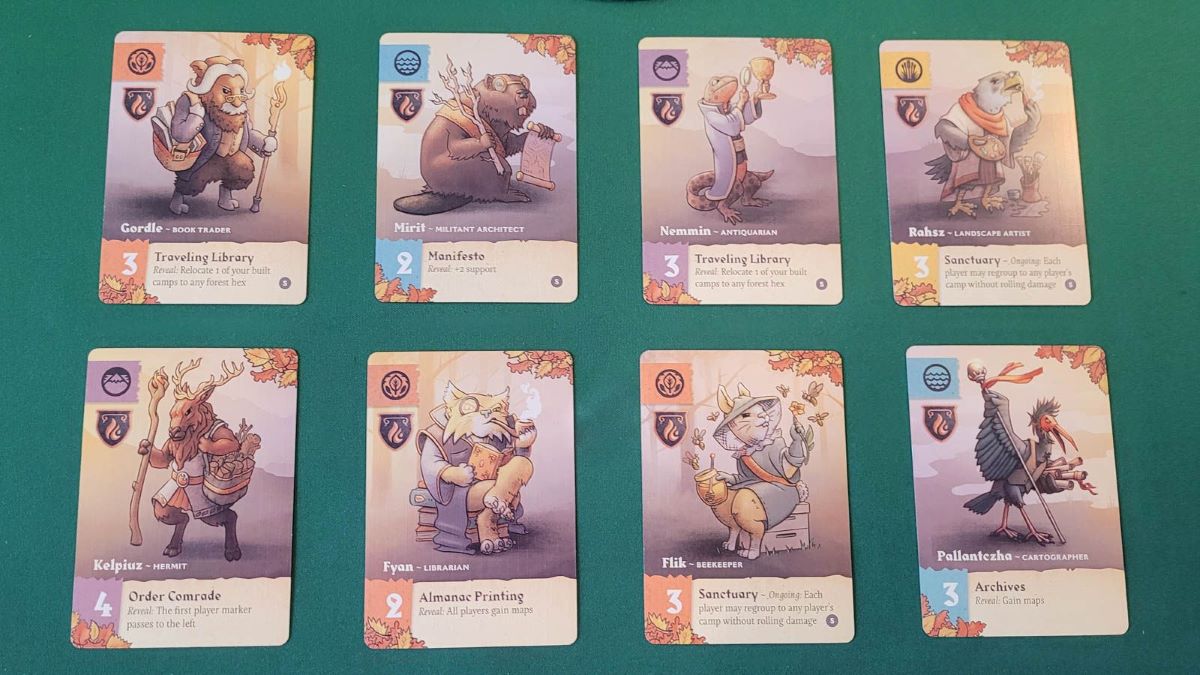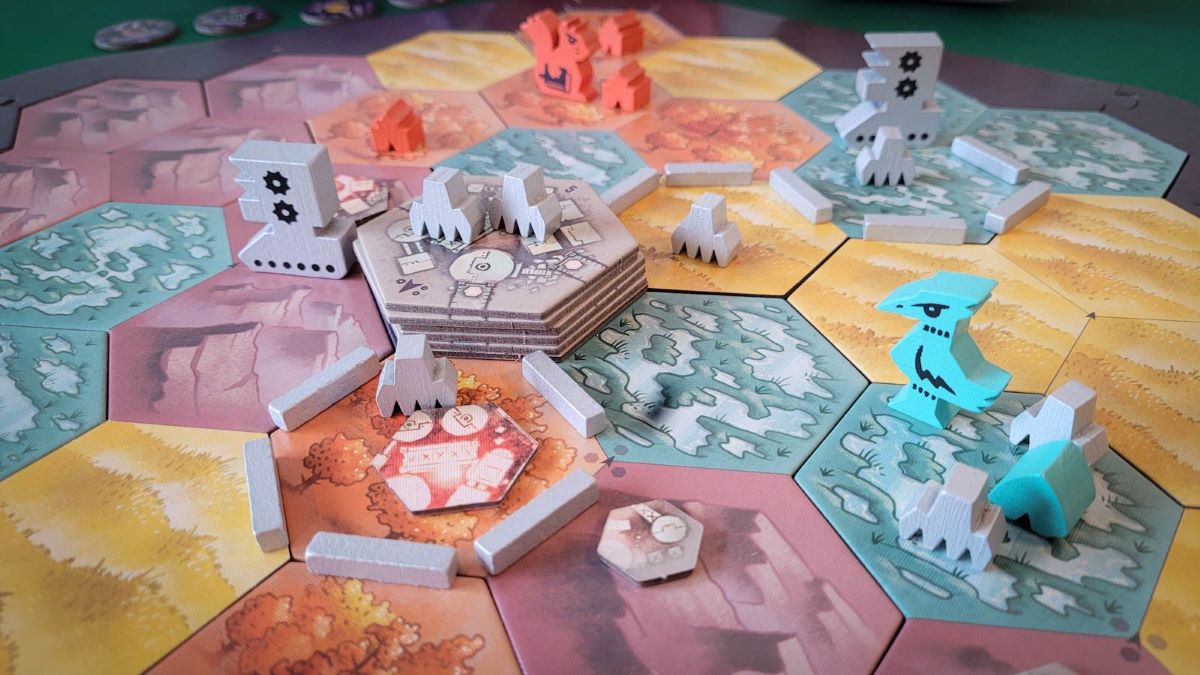Defenders of the Wild Review
Year: 2024 | Players: 1-4 | Min: 60+ | Ages: 14+
This Defenders of the Wild review was made after playing the game six times. The publisher sent us a copy of this game in exchange for an honest review.
What is Defenders of the Wild?
Defenders of the Wild is a cooperative area control game in which you play as different animal factions working together to stop a machine army from taking over your land.
Defenders of the Wild was designed by Henry Audubon and T.L. Simons, and it’s published by Outlandish Games.
Rules Overview
In Defenders of the Wild, you and your teammates are animal organizers fighting against an invading machine army. The machines are building factories and spreading toxic pollution across the land, threatening the natural habitats of various animal factions.
Your mission is to stop the machines by “rewilding” their factories and building camps in your factions’ home habitats while dealing with mechs and other obstacles.
Each faction comes from a different habitat—plains, forests, marshes, or mountains—and has its own unique strengths and abilities. To win, you need to work together to rewild all the factories and ensure that every player puts all of their camps on the board. Along the way, you’ll need to make strategic decisions about where to clear pollution, fight mechs, and breach walls to open up pathways for movement.
Round Structure:
- Organize Phase: At the start of each round, players secretly choose a Defender card from their hand. Communication between players is restricted during this phase. Once chosen, all players reveal their defenders simultaneously. Your defender will determine how many actions you can take during your turn, as well as any instant or ongoing special abilities you have.
- Action Phase: Players take turns spending action points based on the number shown on their Defender cards. Actions include moving to adjacent hexes, building camps, clearing pollution, fighting mechs, or breaching walls. Building camps is essential for expanding your support and drawing new Defender cards, while clearing pollution and fighting mechs both help slow the machines’ advance and get you the support you need to build your camps.
- Machine Phase: The machines take a turn after each player’s turn. Here you flip a Machine card and do what it says. The machines can build walls, spread pollution, deploy more mechs, and move mechs. When habitat hexes become fully enclosed by walls, the machines can build new factories. The more factories and pollution that spread, the harder it becomes to rewild the land and stop the machines.
Key Actions:
- Move: You can move your organizer to adjacent hexes or through habitat corridors (connected hexes of the same type).
- Regroup: You can relocate your organizer to any of your built camps.
- Clear Pollution: Clearing pollution from a hex helps increase your faction’s support.
- Fight Mechs: Defeating mechs grants additional support.
- Breach Walls: Breaching walls helps you move more freely across the board.
- Build a Camp: To build a camp, you must have maxed out your support track and the hex needs to be clear of mechs and pollution. Camps can be placed in your home habitat or on a rewilded factory.
- Rewild Factories: Other than building camps, the ultimate goal is to rewild all the factories. You have to clear all pollution and mechs from a factory hex before flipping it over to its rewilded side, transforming it back into usable land.
Winning and Losing:
You’ll beat Defenders of the Wild if everyone has built all of their camps and all of the factories have been rewilded.
There are multiple ways to lose: if a sixth factory needs to be built, a seventh toxic site has to be placed, or two defenders from the same habitat are killed.
Pros and Cons
Pros
- I like the different ways you can cooperate in Defenders of the Wild. You can activate everyone’s item tokens, breach walls to ease movement for everyone, or fight mechs to help players in danger, among other things. There aren’t any combo actions, but you always feel like you’re contributing to the team.
- The hand management part of the game is a lot of fun and gives you some interesting choices during most turns. For example, if you need one more action to rewild a factory, you can play a card from the same habitat to give you that one extra action. Of course, that means you’ll have one fewer option on your next turn, so you have to decide if it’s worth it. I like those kinds of decisions.
- I like how the map changes as the game progresses, tweaking the puzzle you need to solve. Engines deploy more mechs, change directions, and put up walls while you’re trying to clear those areas. The unpredictability of the Machine deck keeps the game interesting.
- Some unique decisions can come into play when placing camps. You want to do it when you can draw as many cards as possible, so sometimes it might be worth it to wait an extra turn to maximize that action. If you do delay, though, you run the risk of mechs and pollution showing up before your next turn.
- Once you’ve played a few times, there’s a very nice flow to Defenders of the Wild. The decisions are interesting but turns move quickly, so there isn’t much downtime, even at higher player counts.
- The game seems well-balanced at each player count, even at the default difficulty level. All of the games I’ve played so far felt winnable and losable, which is what you want.
- Animals vs. Machines is a very cool theme.
- I like this game’s color palette. Everything looks great on the table.
Cons
- The Organize Phase isn’t as interesting as I had hoped. Secretly choosing Defender cards to begin rounds rarely seems to affect the outcome of a round. The only times it affected us was when multiple players played cards that moved the first player marker, but even then it didn’t make a huge difference. I just wish that phase added a bit more tension to the game.
- I like the modular map, but sometimes the different terrain types are situated in a way that makes the game less interesting. I played a two-player game where we spent a lot of the game on opposite sides of the map since that was where we needed to be to build our camps. Some setups just aren’t as interactive as others.
- The mechs’ Damage Die can make the game feel frustratingly tough at times. Unlucky rolls can force you to spend actions healing far more often than you’d like. While the game is designed to play this way, a bad run of luck can really dampen the fun since it reduces your ability to strategize effectively and help the team.
- This is minor, but I don’t think the Direction circle and the Toxic Site circle were necessary. The direction could have been tracked on one of the perimeter tiles or a card, and the Toxic Site tokens could just be placed next to the map. Or, both could have been combined into a single circle or card.
Final Thoughts
I’ve had a really good time playing Defenders of the Wild. The cool theme, distinct animal factions, unique engine and wall mechanics, and the game’s overall look combine to create a fun co-op experience.
It has the familiar “take turns then bad things happen” cooperative game flow, but the turns themselves and the machines’ unique “bad things” make the game feel different than other co-ops, which is great! The animals are fun to control and the machines are fun to face off against, which is what I was hoping for.
I can’t speak to the game’s long-term replayability yet, but I think my group will keep playing until we can consistently beat it with at least five of those Difficult Machine cards mixed into the deck.
If you like the classic co-op flow of games like Pandemic and Horrified, and the Animals vs. Machines theme interests you, I definitely recommend giving Defenders of the Wild a try.
I still have quite a few other 2024 co-op board games to play, but I’m pretty confident Defenders of the Wild will end up being one of my favorites of the year.
- Update: Defenders of the Wild was added to the Best Cooperative Three-Player Board Games list!
- Update 2: It’s also now on the Best Co-op Board Games page!
Defenders of the Wild Links
BGG | Miniature Market | Amazon
Thanks for taking the time to read our Defenders of the Wild review!
Be sure to also take a look at our Best Cooperative Board Games list and the other board game rankings.
Subscribe to our newsletter if you want more co-op board game content sent right to your inbox!
[Sassy_Social_Share title=”Share this page”]






